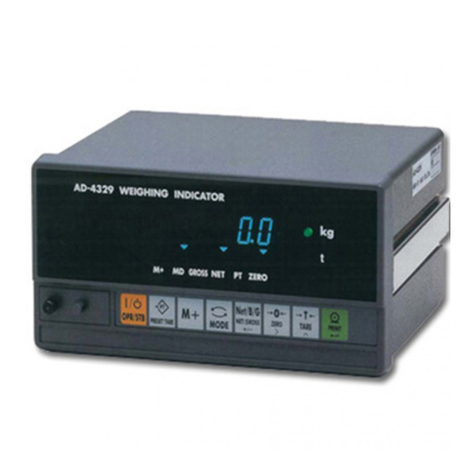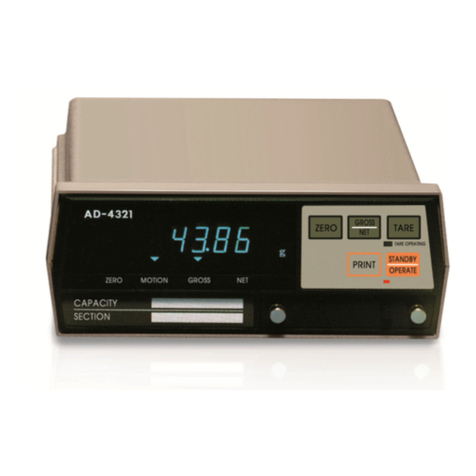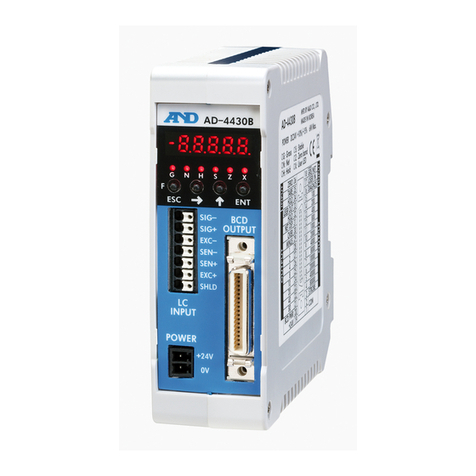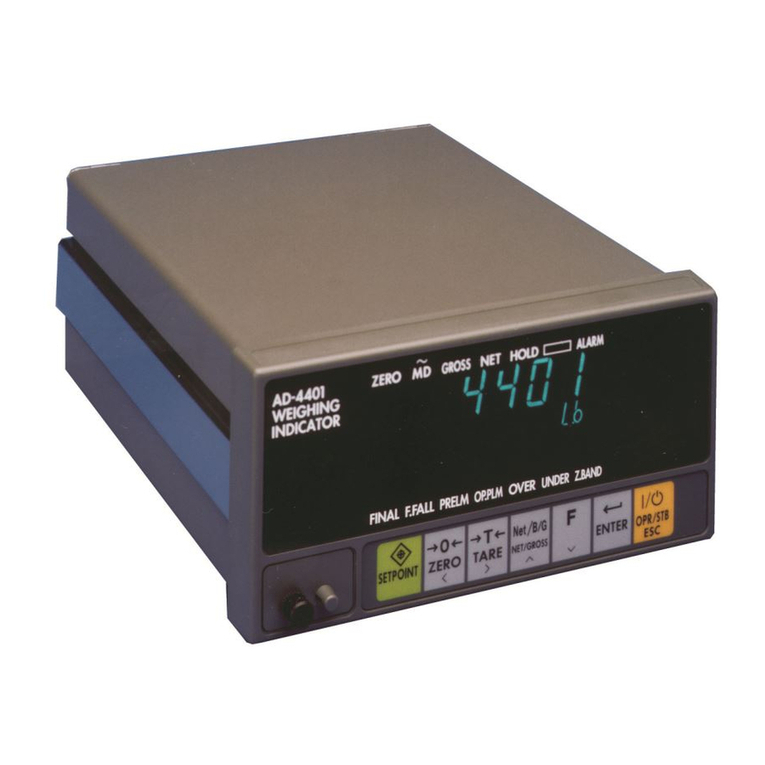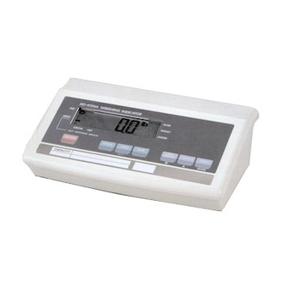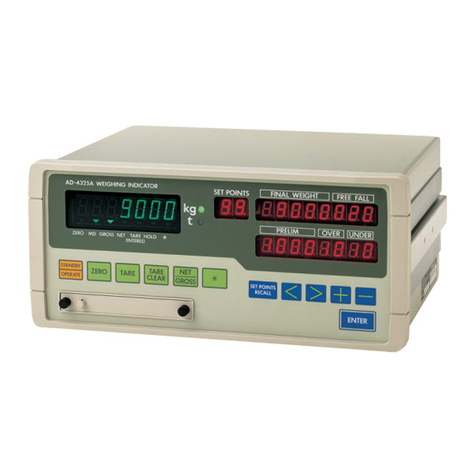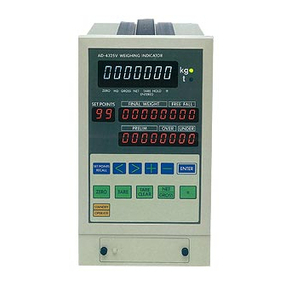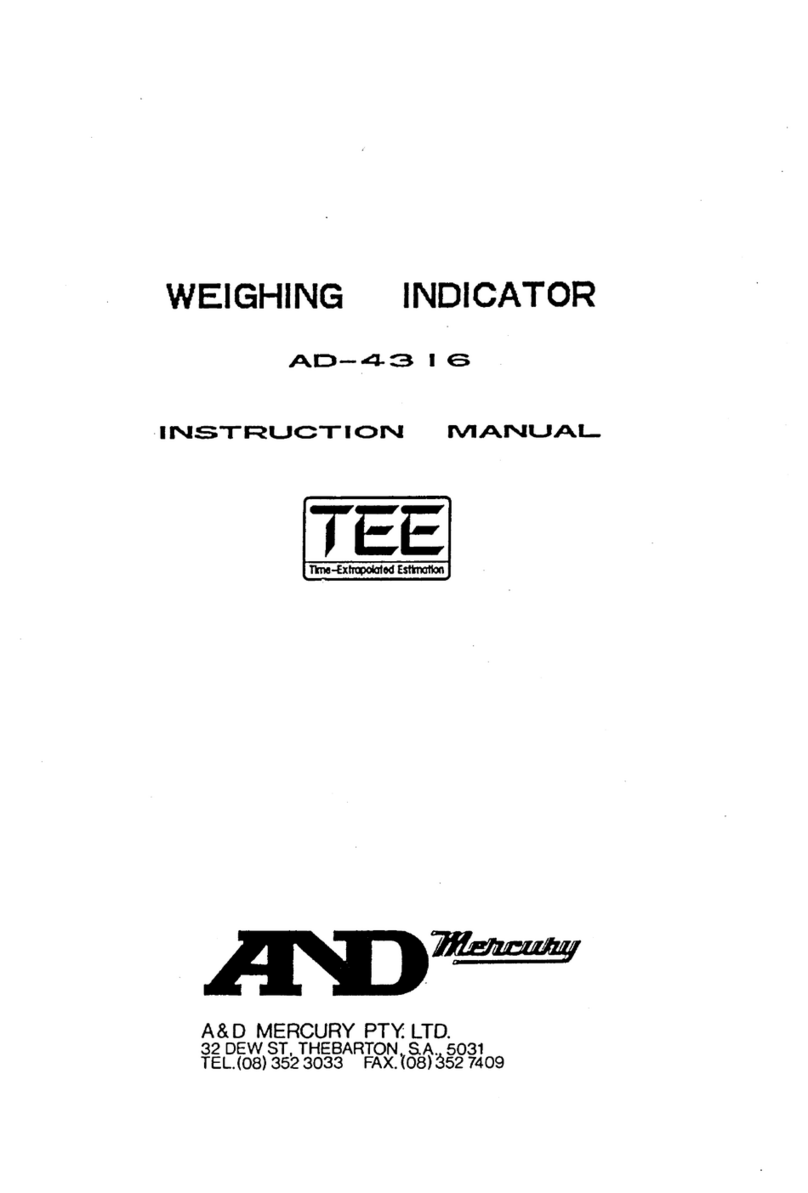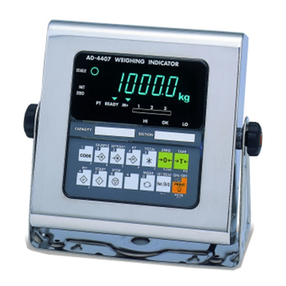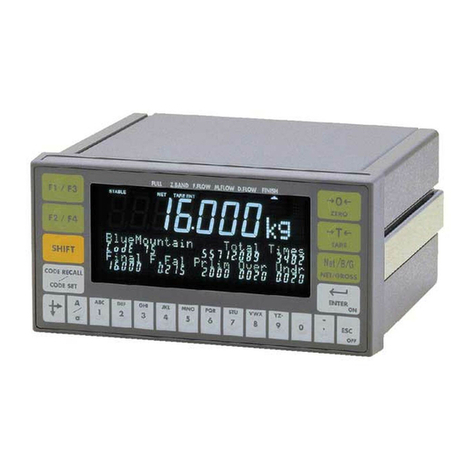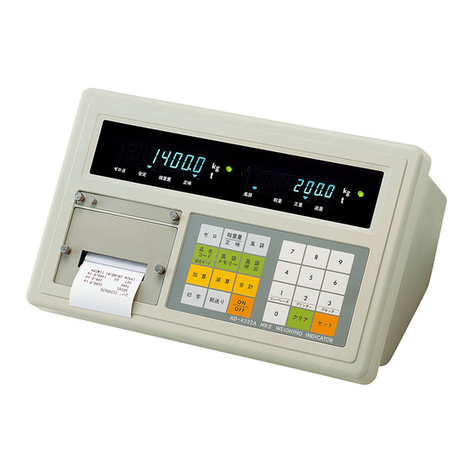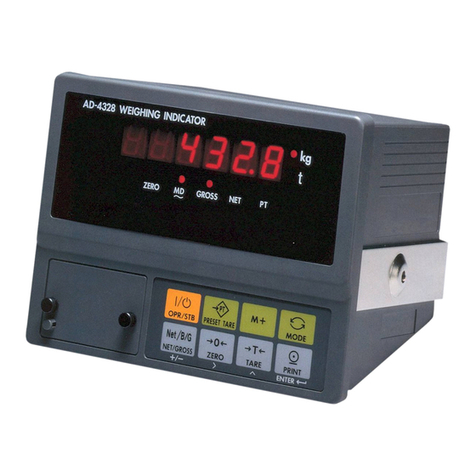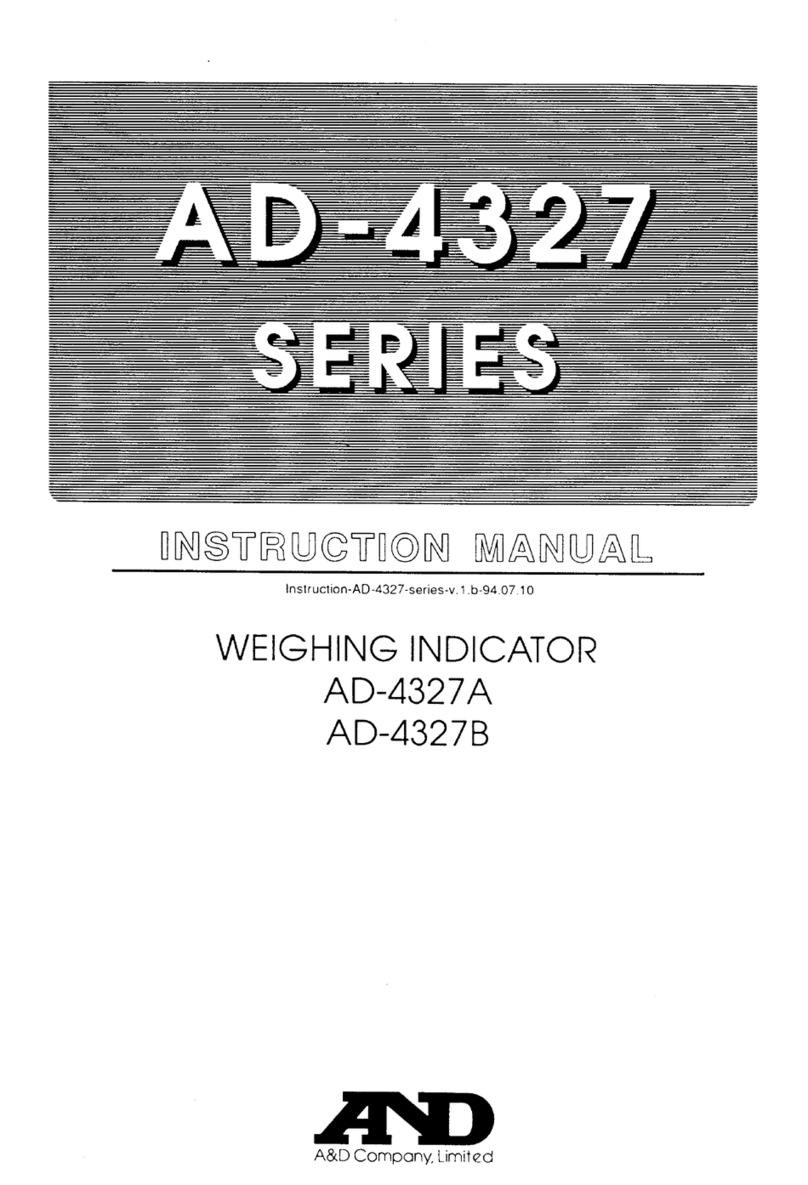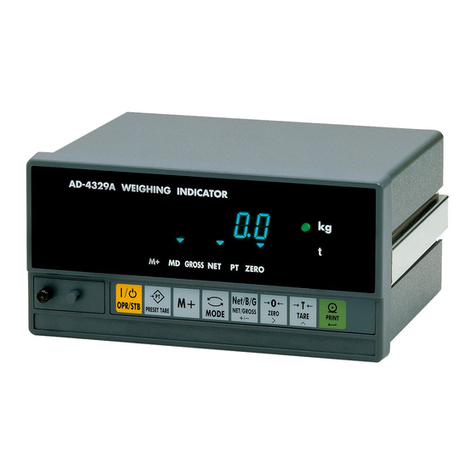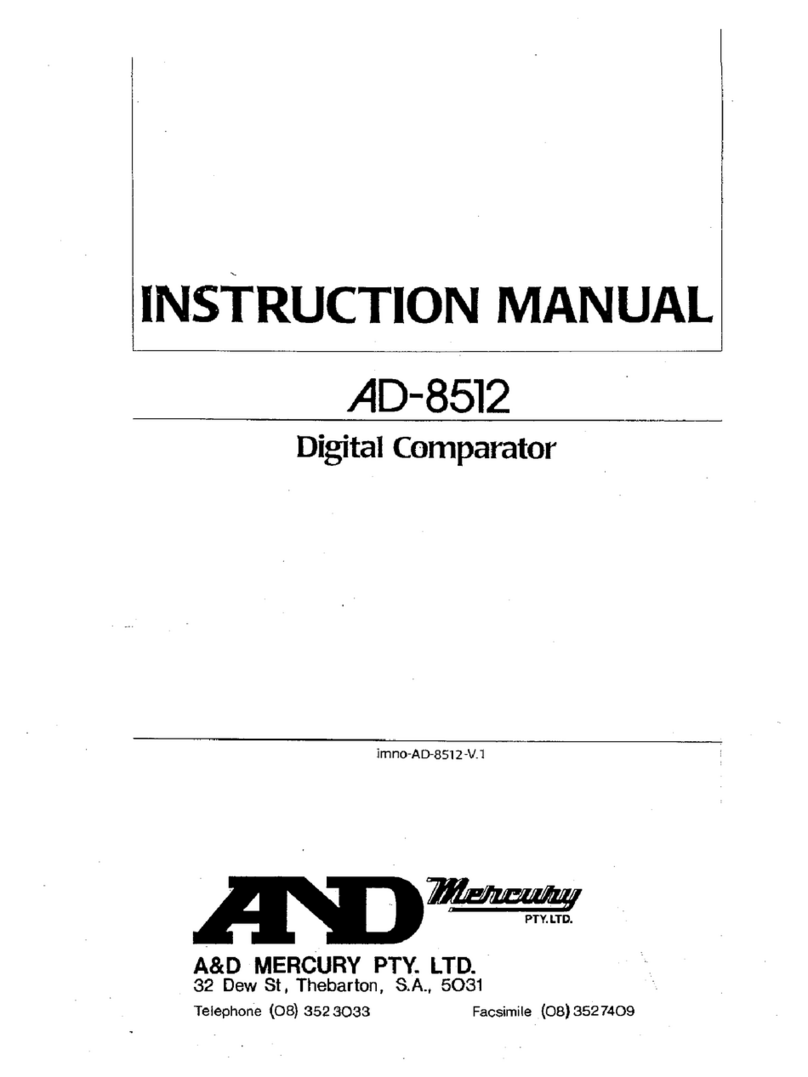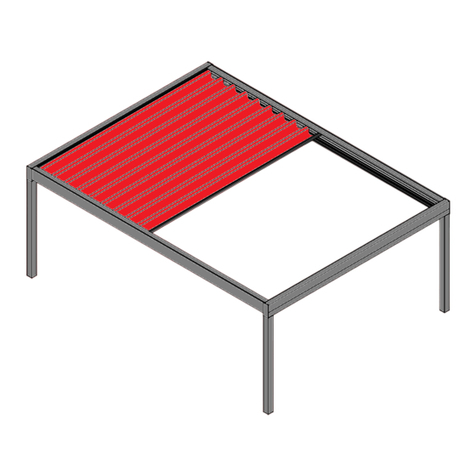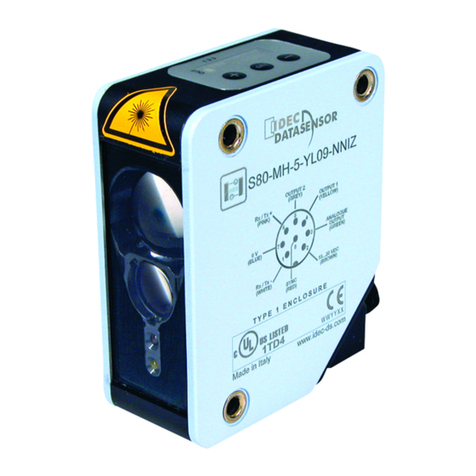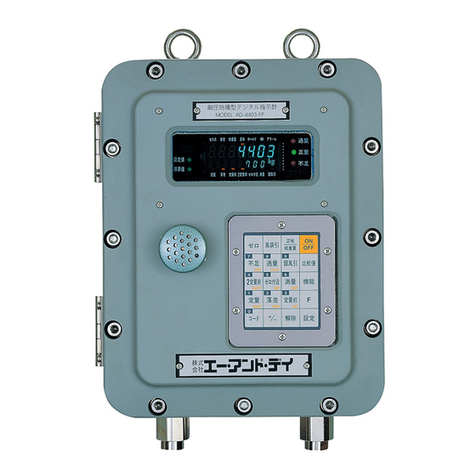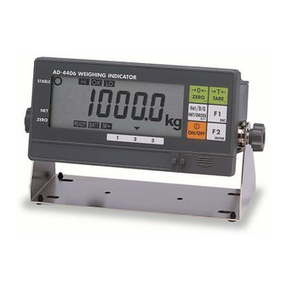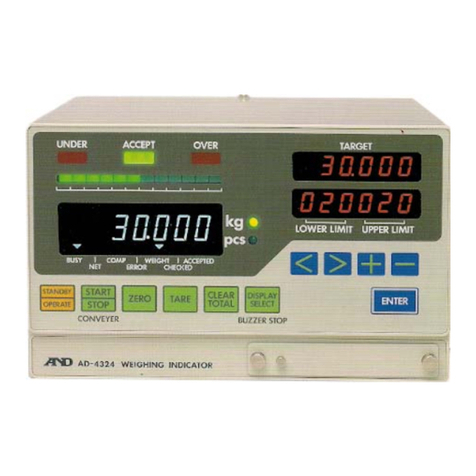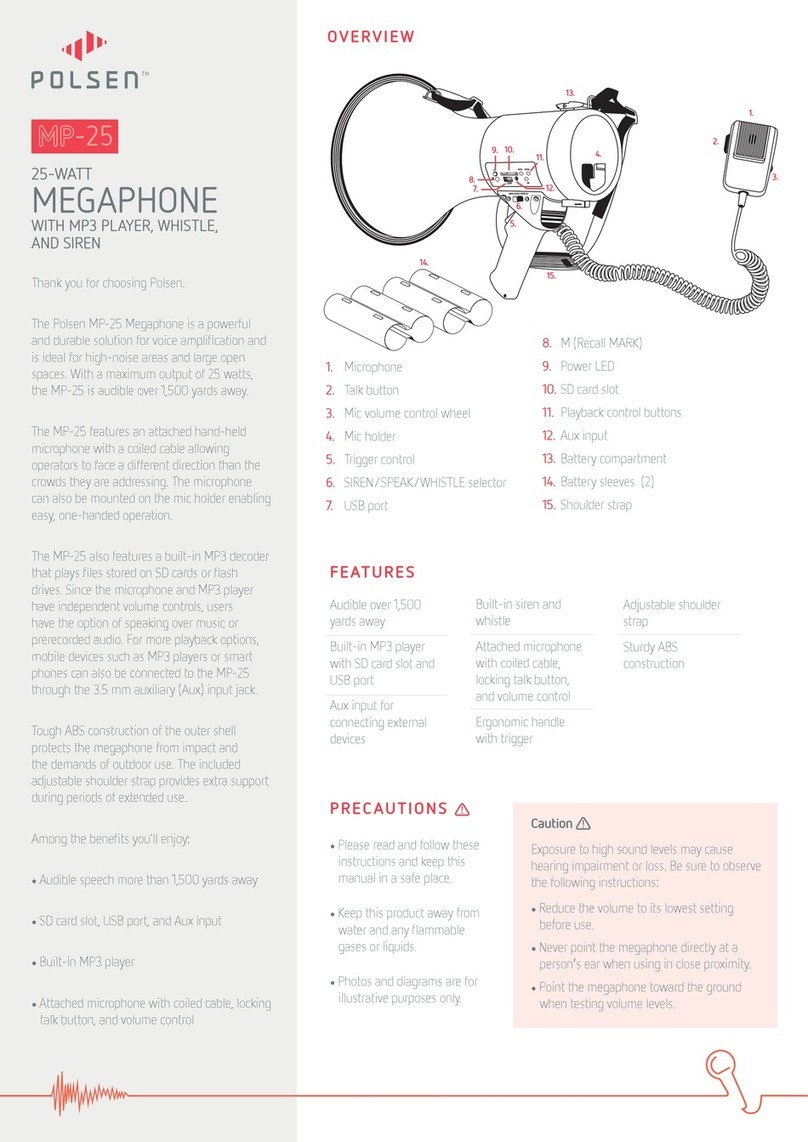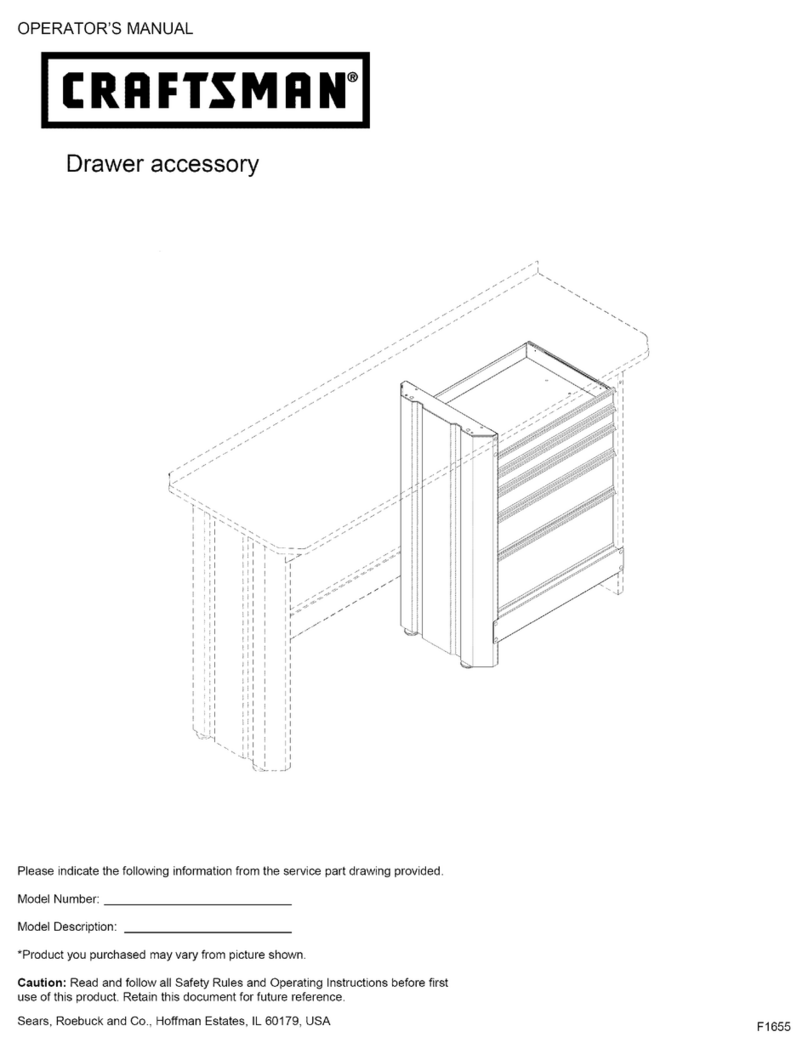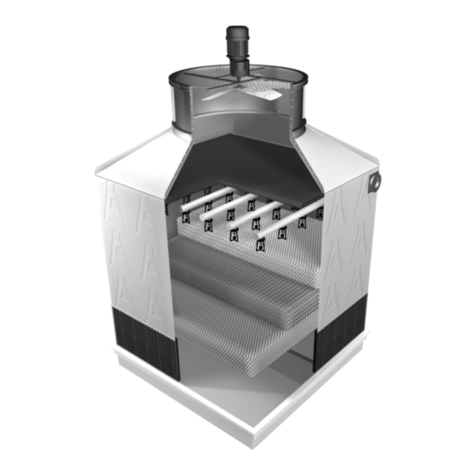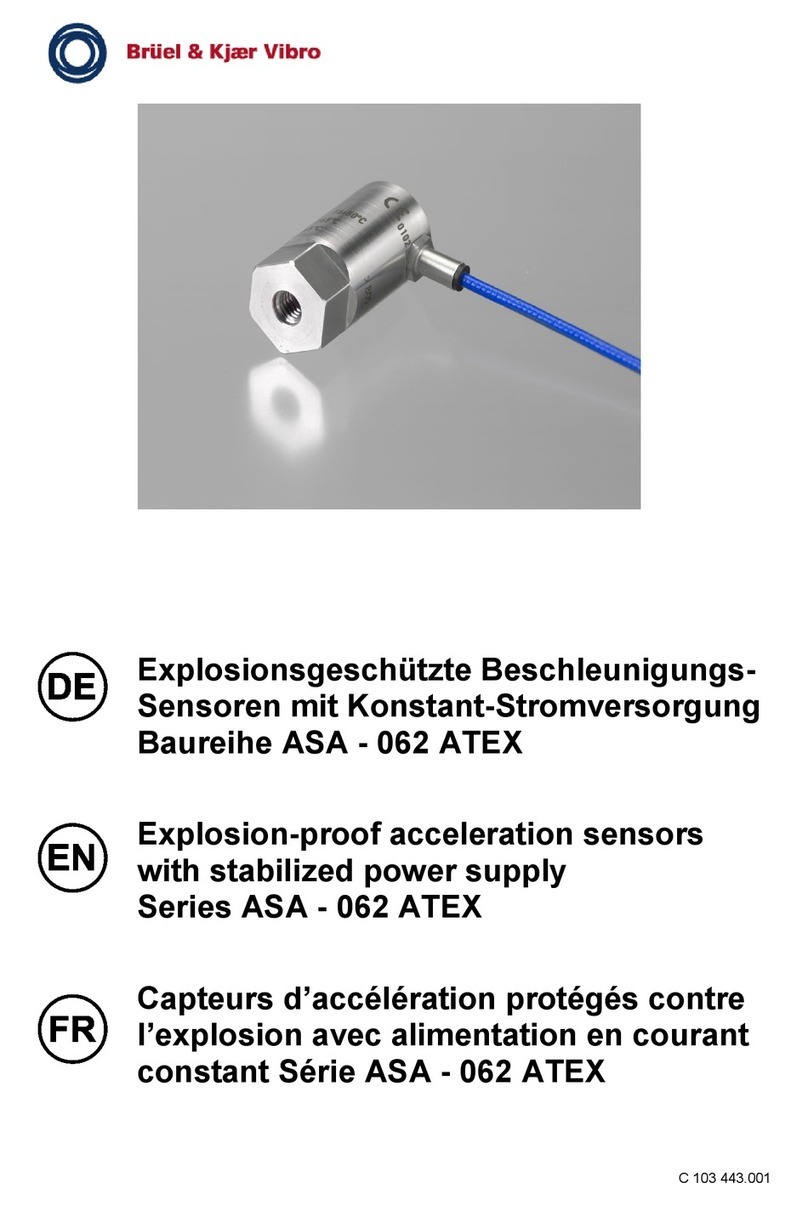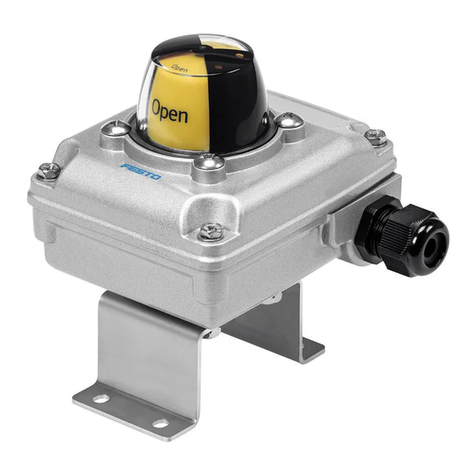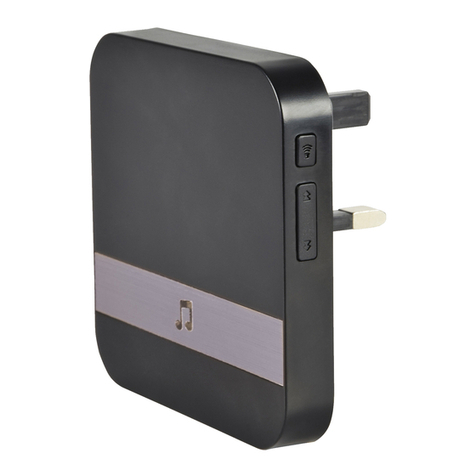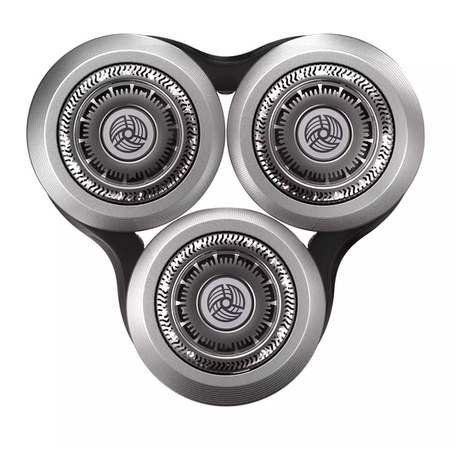6.3.
Digital Linearization ( )
Digital linearization is the non-linearity compensation function that can rectify or
reduce linearity deviation between zero point and weighing capacity.
Up to four points can be specified except zero. (Refer to )
Relationship of points : Zero = < < < <
The high-order correction curve is used so that zero point and individual points
are arranged in a straight line.
Digital linearization includes span calibration.
When and a number are displayed, an error has occurred. Refer to
"Calibration Error" for details.
A flashing decimal point means "no weighing value".
Before calibration, turn on the AD4430B more than 10 minutes so as to avoid
temperature drift (change).
Step 1 When turning off the display, press and hold
the key and press the key ( +
key).Then of calibration mode
is displayed. Press the key to display
.
Step 2 Press the key to select and
press the key to enter digital
linearization.
Step3 of the zero point is displayed.
Step4 Place nothing on the pan.
While LED is displayed, press the
key to store the weighing value.
Then is displayed for 2 seconds.
Step5 When displaying ,
press the key to select
a mass value. Specify it using
the and key.
Step 6 Place the mass on the pan.
While LED is displayed,
press the key to store
the weighing value.
Then is displayed
for 2 seconds.
Step7 is displayed. Repeat the same
operation as Step 5 and Step 6 at the
second point.
Step8 is displayed. Repeat the same
operation as Step 5 and Step 6 at the third
point.
Step9 is displayed. Repeat the same
operation as Step 5 and Step 6 at the fourth
point.
Step 10 is displayed. Press the key
to store new parameters into FRAM and
display .
Step 11 Press the key to return to weighing mode.
Remove all of mass from the pan.
7. Function Mode (Function List)
The function mode stores parameters to control the weighing module.
The parameters are stored even without power supplied.
7.1.
Outline
Types of Functions
............Calibration
............Linearity
.............Basics
............Hold function
............BCD output
The input voltage of the zero point ( ), the span input voltage ( ),
mass for span input voltage ( ) are revised in calibration mode.
The decimal point flashes in function mode.
If pressing the key while displaying the digital filter ( ), the current
weighing value can be monitored. Press the key again to return function
mode.
7.2.
Operation
7.2.1. Select Modes Under Function Mode
..............Selects a type of select mode (3 upper figures)
..........Enters a selected mode.
..............Selects an item under the selected mode (2 lower figures)
..........Enters the item.
..........Stores parameters and returns to weighing mode.
7.2.2. Parameters SelectionAnd Digital Parameters
P Type of parameterselection ( all figures flashing)
..........Selects a parameter.
.......Activates (store) parameter and returns to select mode.
.......Deactivates parameter and returns to select mode.
D The type to change value ( figure flashing )
..........Moves the flashing figure.
..........Changes the value of the flashing figure.
.......Activates (store) value and returns to select mode.
.......Deactivates value and returns to select mode.
7.3.
Types and Items
7.3.1. Calibration ( ) Of Select Mode
Item
Range Item Name Descriptions Default
Type
0 to 0.0000 Decimal point
position Decimal point position of value.
0 0.0 0.00 0.000 0.0000 0
P
1 to 50 Minimum division
(A scale / digit) Minimum division of value.
1 2 5 10 20 50 1
P
1 to 99999 Weighing capacity
(Max. measurement) Measurement can be displayed up to +8 digits
(8 scales) from capacity. Decimal point
depends on .70000
D
0 to 100 Zero adjustment
range The range that the key (zero key) works.
Deviation from the calibrated zero point [%]. 2
D
0.0 to 5.0 Zero tracking time Used with for zero tracking [sec.] 0.0
D
0.0 to 9.9 Zero tracking band Used with for zero tracking [digit] 0.0
D
0.0 to 9.9 Stability detection
time Used with for stability detection [sec.] 1.0
D
0 to 9 Stability detection
band Used with for stability detection [digit] 2
P
0 to 1 Tare and zero
adjustment when
unstable
The adjustment when value is unstable.
0: Disables both functions.
1: Enables both functions. 1
P
0 to 1 Tare when the
gross weight is
negative
Tare when the gross weight is negative.
0: Disables tare.
1: Enables tare. 1
P
0 to 1 Output when
overflow and
unstable
Serial output when overflow and unstable.
0: Disables output.
1: Enables output. 1
P
1 to 3 Exceeding negative
gross weight
Judgment when thenegative grossisexceeded.
1: Gross < -99999
2: Gross < -capacity
3: Gross < -19 digit
1
P
1 to 2 Exceeding negative
net weight Judgment when the negativenetis exceeded.
1: Gross < -99999 2: Gross < -Capacity 1
P
0 to 1 Clear the zero
value Select to clear the zero value.
0: Disable 1: Enable 1
P
0 to 1 Zero setting when
power is turned on When turning power on,
0: Disable 1: Enable 0
P
-7.0000to
7.0000 Input voltage at
zero Input voltage of the zero point [mV/V] 0.0000
D
0.0001 to
9.9999 Input voltage at
span Input voltage of the full scale [mV/V] 3.2000
D
1 to 99999 Calibrationweight
corresponding to
inputvoltage at span
Mass value to equivalent to span input
voltage. ( ) Decimal point depends on
.32000
D
9.7500 to
9.8500
Gravity acceleration
of place of
calibration Gravity acceleration of the place where
calibrating the module. [m/s2] 9.8000
D
9.7500 to
9.8500 Gravity acceleration
of place of use Gravity acceleration of the place where using
the module. [m/s2] 9.8000
D
0 to 1 Disable averaging
hold When turning on, the zero operation.
0: Enable 1: Disable 0
P
7.3.4. Hold Function ( ) Of The Select Mode
Item
Range Item Name Descriptions Default
Type
0.00
to9.99 Average
time Time to calculate the average. [sec.]
0.00 : Not used 0.00
D
0.00
to9.99 Start wait
time Time to wait before commencing hold or
averaging. [sec.] 0.00
D
0 to 2 Condition of
automatic
start
Conditionfor starting the holdor averaging.
0:Not used 2: Above the near-zero range
1: Above the near-zero range, and stable 0
P
0 to1 Release due
to falling
control input Release when control input is falling.
0: Do not release 1: Release 1
P
0.00
to9.99 Time release Release after a set amount of timehas
passed. [ sec.] 0.00 : Continue 0.00
D
0 to 99999 Release due
to range of
fluctuation
Release when fluctuation from the holding
value exceeds a set value. Decimal point
depends on . 0 : Continue 0
D
0 to 1 Release in
near-zero
range
Release when the weighing value is in the
near-zero range.
0: Do not release. 1: Release. 0
P
7.3.5. BCD Output ( ) Of The Select Mode
Item
Range Item Name Descriptions Default
Type
1 to4 Output data 1: Weighing value 3:Netweight
2:Gross weight 4: DataspecifiedatBCD input 1
P
1 to3 Data transfer
mode 1: Stream 3: Manual printing
2: Automatic printing 1
P
5to1000 Data transfer
rate
5 times/sec.
10 times/sec. (Depends on )
20 times/sec.
100 times/sec.
1000 times/sec.
20
P
1 to2 Output logicof
datatransfer 1: Positive logic 2: Negative logic 2
P
1 to2 Output logicof
negativesign 1: Positivelogic 2: Negative logic 2
P
1 to2 Output logic
of status 1: Positive logic 2: Negative logic 2
P
1 to2 Output logic
of strobe 1: Positive logic 2: Negative logic 2
P
0 to5 Input
selection
0: None
1: Clear zero
2: Clear tare
3: Changing between gross and net
4: Print command
5: key
3
P
0 to12 Output
selection
0: None
1: Stabilization
2: During tare
3: Zero band
4: Hold busy state
5: HI output (Over upper limit)
6: OK output (Within upper and lower limits)
7: LO output (Under lower limit)
8: During operating weighing (On)
9: During operating weighing (1 Hz)
10: During operating weighing (50 Hz)
11: Alarm(Zero correction errorand tare error)
12: Busy key
1
P
3-23-14 Higashi-Ikebukuro, Toshima-ku, Tokyo 170-0013, JAPAN
Telephone: [81] (3) 5391-6132 Fax: [81] (3) 5391-6148
7.3.2. Linearity ( ) Of The Select Mode
Item
Range Item Name Descriptions Default
Type
1 to 4 Number of input
points Number of adjustment point. If 0, 1 or 2 is
selected, digital linearization is not used. 0
P
7.0000 to
7.0000 Linear-zero Input voltage for linear-zero input. [mV/V] 0.0000
D
0 to 99999 Linear 1
Mass value The mass value for linear 1 input.
Decimal point depends on .0
D
0.0000 to
9.9999 Linear 1
Span voltage The span voltage between linear-zero and linear
1 input. [mV/V] 0.0000
D
0 to 99999 Linear 2
Mass value The mass value for linear 2 input.
Decimal point depends on .0
D
0.0000 to
9.9999 Linear 2
Span voltage The span voltage between linear-zero and linear
2 input. [mV/V] 0.0000
D
0 to 99999 Linear 3
Mass value The mass value for linear 3 input.
Decimal point depends on .0
D
0.0000 to
9.9999 Linear 3
Span voltage The span voltage between linear-zero and linear
3 input. [mV/V] 0.0000
D
0 to 99999 Linear 4
Mass value The mass value for linear 4 input (Full scale).
Decimal point depends on .0
D
0.0000 to
9.9999 Linear 4
Span voltage The span voltage between linear-zero and linear
4 input (Full scale). [mV/V] 0.0000
D
7.3.3. Basics ( ) Of The Select Mode
Item
Range Item Name Descriptions Default
Type
0000
to 1111 Disable key
switchs
Figure corresponds to each key (switch).
These are enabled at weighing mode.
Figure 4 fig. 3 fig. 2 fig. 1 fig.
Parameter 0: Enable 1: Disable
0000
2進数
D
0 to 7 key
0: None 4: Momentaryswitch
1: Printcommand 5: Display exchange
2: Hold 6: Tare clear
3: Alternative switch 7: Zero clear
(depends on )
5
P
1 to 3 Display update
rate 1: 20 times/s 2: 10 times/s 3: 5 times/s 20
P
0 to 9 display
0: None
1: Zero tracking in progress
2: Alarm (Zero range setting error, over)
3: key status
4: Zero band
5: HI output (Over the upper limit value)
6: OK output(Betweenupperandlowerlimitvalues)
7: LO output (Below the lower limit value)
8: User input 1
9: User output 1
0
P
0 to 16 Low pass digital
filter
Selects a cutoff frequency.
0: None 6: 20.0 Hz 12: 2.8 Hz
1: 100.0 Hz 7: 14.0 Hz 13: 2.0 Hz
2: 70.0 Hz 8: 10.0 Hz 14: 1.4 Hz
3: 56.0 Hz 9: 7.0 Hz 15: 1.0 Hz
4: 40.0 Hz 10: 5.6 Hz 16: 0.7 Hz
5: 28.0 Hz 11: 4.0 Hz
15
P
1 to 3 Hold 1: Hold immediately
2: Peak hold
3: Averaging hold 1
P
-99999 to
99999 Set value of
near-zero The reference value for near-zero.
Decimal point depends on .10
D
1 to 2
Massto be compared
with near-zero
1: Gross weight 2: Net weight 1
P
-99999 to
99999 Set value of
upper limit Reference value for the upper limit.
Decimal point depends on .10
D
-99999 to
99999 Set value of
lower limit Reference value for the lower limit.
Decimal point depends on .-10
D
1 to 2
Massto be compared
with upper & lowerlimit
1: Gross weight 2: Net weight 1
P
1 to 2
Output logic of upper
and lower limit
The logic of the comparator function output.
1: Positive logic 2: Negative logic 1
P
-


